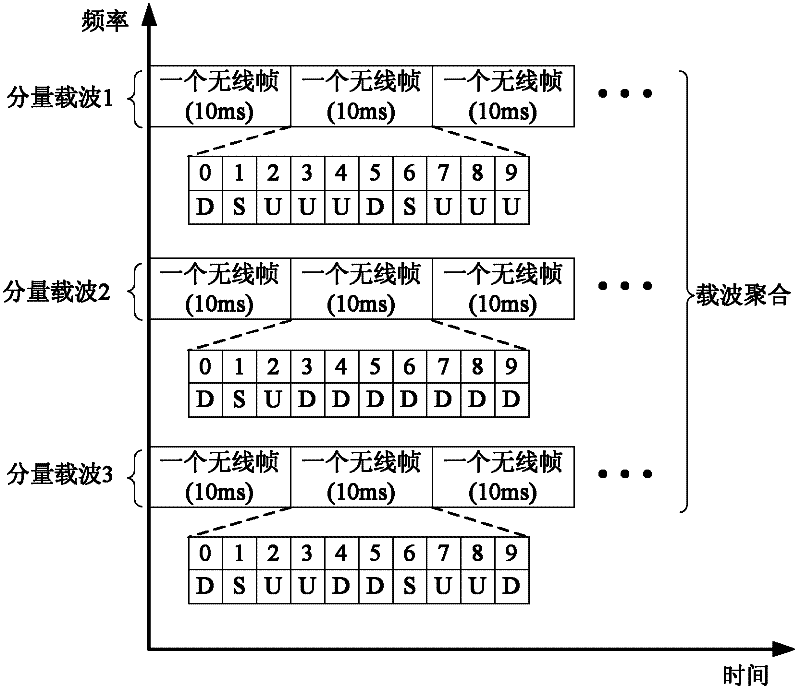A carrier aggregation configuration method and device
A technology of carrier aggregation and configuration method, which is applied to the separation device of transmission path, error prevention/detection using return channel, digital transmission system, etc., and can solve the problems of uncertain subframe type of mixed subframe, confusion of HARQ timing relationship, etc.
- Summary
- Abstract
- Description
- Claims
- Application Information
AI Technical Summary
Problems solved by technology
Method used
Image
Examples
specific Embodiment 1
[0094] Specific embodiment 1 describes an embodiment in which a hybrid subframe supports unidirectional transmission and sets a transmission mode with reference to the subframe type of the subframe at the subframe time where the hybrid subframe is located on the primary component carrier.
[0095] Such as Figure 4 As shown, there are component carrier 1, component carrier 2, component carrier 3, and component carrier 4 in the system. The four component carriers are configured with different uplink and downlink ratios. The configuration of component carrier 1 is the uplink and downlink ratio configuration 0 in Table 1. , component carrier 2 is configured with uplink and downlink ratio configuration 1 in Table 1, component carrier 3 is configured with uplink and downlink ratio configuration 3 in Table 1, and component carrier 4 is configured with uplink and downlink ratio configuration 4 in Table 1.
[0096] based on Figure 4 Given the component carrier and its uplink and dow...
specific Embodiment 2
[0101] The second specific embodiment describes the implementation of hybrid subframes that support unidirectional transmission and fixedly allows the downlink transmission of hybrid subframes, and adopts the timing relationship between the uplink HARQ and downlink HARQ of the scheduled carrier in the first method to control the cross-carrier scheduled components The principle of carrier data scheduling.
[0102] based on Figure 5 Given the component carrier and its uplink and downlink ratio configuration, the base station (eNodeB) configures carrier aggregation for LTE-A TDD terminals with carrier aggregation capability:
[0103] The base station configures the corresponding uplink-downlink conversion period according to the uplink and downlink ratio of the component carrier, divides the component carrier 1 and the component carrier 2 with a 5ms conversion period into a group (marked as carrier aggregation group A), subframes 4 and 9 in group A are "Mixed Subframes".
[01...
specific Embodiment 3
[0110] The third specific embodiment describes an implementation mode in which mixed subframes support unidirectional transmission and fixedly allows downlink transmission of mixed subframes, and the scheduling modes of mode 2, mode 3 and mode 4 are adopted.
[0111] based on Figure 5 Given the component carrier and its uplink and downlink ratio configuration, the base station (eNodeB) configures carrier aggregation for LTE-A TDD terminals with carrier aggregation capability:
[0112] The base station configures the corresponding uplink-downlink conversion period according to the uplink and downlink ratio of the component carrier, divides the component carrier 1 and the component carrier 2 with a 5ms conversion period into a group (marked as carrier aggregation group A), subframes 4 and 9 in group A are "Mixed Subframes".
[0113]The base station can configure group A to terminals with carrier aggregation capabilities to increase the data transmission rate, and designate a c...
PUM
 Login to View More
Login to View More Abstract
Description
Claims
Application Information
 Login to View More
Login to View More - R&D
- Intellectual Property
- Life Sciences
- Materials
- Tech Scout
- Unparalleled Data Quality
- Higher Quality Content
- 60% Fewer Hallucinations
Browse by: Latest US Patents, China's latest patents, Technical Efficacy Thesaurus, Application Domain, Technology Topic, Popular Technical Reports.
© 2025 PatSnap. All rights reserved.Legal|Privacy policy|Modern Slavery Act Transparency Statement|Sitemap|About US| Contact US: help@patsnap.com



